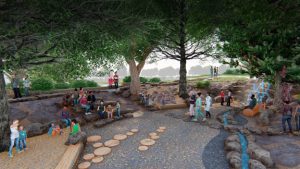A Stream Will Run Through It

Historic City Ditch Will Feed Nature Play Project In City Park
By Cara DeGette
GPHN Editor
Thanks to the oldest surviving relic of Denver’s pioneer days, City Park’s new Nature Play will be built with a replica of a mountain stream running through it.
After five years of planning and extensive outreach to residents, the $7.9 million City Park Nature Play project broke ground in late January. Just south of the Denver Museum of Nature and Science in City Park, it is scheduled to be completed late next year.
Denver taxpayers will pay half the total cost for the Nature Play via the 2018 voter- approved bond for new park projects; the museum is paying for the other half via ongoing fundraising efforts.

When it’s finished, the natural area will include pathways with overhead shade from the mature canopy of existing trees. A playground will include swingsets, slides and structures to climb on, with a 20-foot tall Rocky Mountain Bighorn Sheep sculpture. Additional play features will be in the shapes of other wild animals common to Colorado. Native plants will support bees and other pollinators, and 52 new trees will be planted.
Central to the entire project is the restoration of the historic waterway that used to flow through the southeast part of City Park — part of Denver’s historic City Ditch.
City Ditch, which was completed in 1867, has been described as the “oldest working thing in Denver.” The Ditch, 4-feet deep by 6-feet wide, was dug to divert water from the South Platte River near Littleton. It stretches for 26 miles north and east, through Englewood, and what is now Washington Park, the Country Club and City Park. An engineering feat in its time, the Denver Ditch brought water to what was then treeless, bare prairie, providing irrigation to allow trees and gardens and crops to grow, allowing the city to grow up as a verdant Queen City of the Plains.
The Denver Ditch is still visible in Littleton and Englewood, and it flows through Washington Park and feeds Smith Lake there. The rest of the Ditch is now buried and flows through pipes. When the water ultimately reaches City Park, it empties into Ferril Lake — the larger of the lakes in the park.
In the early part of the 20th century, the original Denver Botanic Gardens was in City Park, in the spot where the new Nature Play area is being built. Designed by famous Denver landscaper and city planner Saco DeBoer, the flow of water through the gardens was called the DeBoer Waterway. In the 1950s the Botanic Gardens was moved to its current site at York Street next to Cheesman Park.
The Denver Ditch continues to feed Ferril Lake in City Park, but the DeBoer Waterway was shut off around 2010, after it fell into disrepair. As part of the new City Park Nature Play project, the DeBoer segment will be repaired, feeding what will become the new urban creek.
Jacqueline Altreuder, the director of volunteer engagement for the museum, presented an update and overview of the project to enthusiastic feedback during the January meeting of Greater Park Hill Community, Inc.
Over the past five years, Altreuder said, project organizers surveyed and sought feedback from thousands of residents. Children, as well as grown-ups, were encouraged to submit their ideas for the kind of project they wanted. The response was overwhelming, she said. People wanted a play area that was authentic and natural. They wanted shade. They wanted it to be welcoming to all ages, where people could come and sit and perhaps read, and savor being outside. Nearly 98 percent of the people who responded to the surveys said they wanted water flowing through it.
“What we kept hearing is people wanted a natural play experience, and wanted the old waterway restored,” she said.
And so, the Denver Museum of Nature and Science, in conjunction with the Denver Parks and Recreation department, proceeded with a project that is envisioned as a classically Colorado setting — think the mountains come to the city, with pathways, a creek, and plenty of shade trees.
“I’m super excited for daylighting the historic waterway,” said GPHC board member Nam Henderson.
Maria Flora, who also serves on the board of the registered neighborhood organization, told Altreuder she appreciated the “genuine community outreach” that went into the planning. Flora complimented organizers for creating a project that truly reflected the public’s desire.
“You specifically listened, especially to the little kids,” she said.

